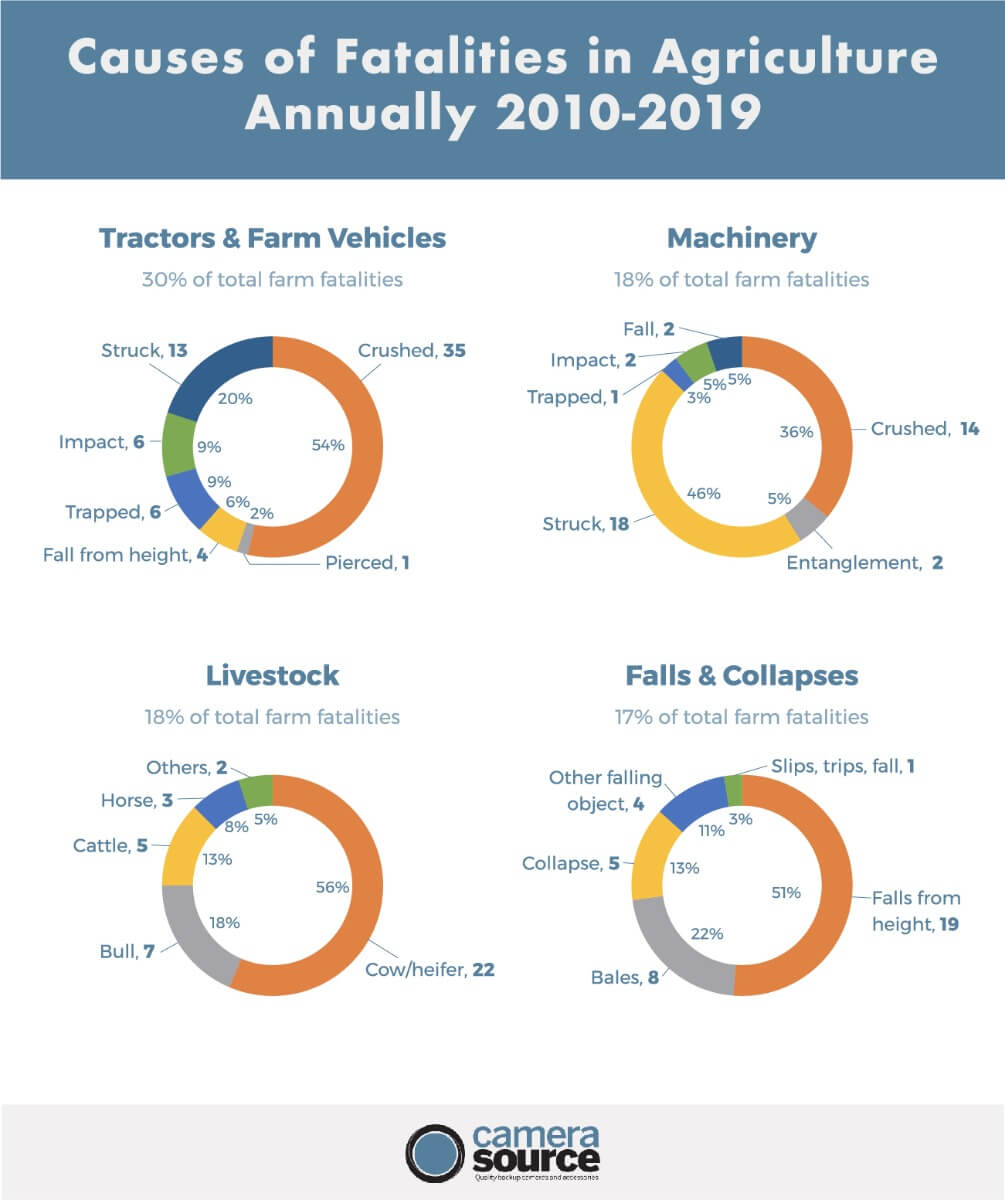Agriculture is a hard, and dangerous business. Not only does it require physical labor, but there’s a prerequisite to have a certain level of technical knowledge as well. According to the National Institute of Food and Agriculture (NIFA), agriculture has high rates of fatalities and serious injuries, and the sector ranks among the most dangerous professions in the United States. Training farmers, ranchers, and most importantly seasonal labor to operate machinery safely and use protective equipment correctly can help reduce the high number of accidents.Thus, proper safety training can go a long way toward:
- Avoiding serious and fatal accidents
- Proper equipment use and maintenance
- Reducing income lost to agricultural accidents
Camera Source is here to support farmers and agricultural workers with the best tools and equipment they need. We prioritize transportation safety, including that of agricultural transportation and machinery operation. In this article, we’ll provide an overview of different safety topics as well as some helpful tips.
The Importance of Agriculture Safety
The well-being of farmers and agricultural workers is vital to strong communities and the U.S. economy. Safety training gives farm families the awareness and information they need to reduce safety hazards and protect their children who often work on the farm.
Agriculture Health & Safety Topics
There are numerous dangers and risks for agricultural workers.
- Chemicals - Exposure to farm chemicals, such as pesticides and fertilizers, as well as toxic gases which may be produced from common farm practices like manure decomposition and silo crop storage.
- Dust - Exposure to high levels of dust, which can contain mold, bacteria, and animal droppings, among other things
- Falls - Falling from ladders, farm equipment, grain bins, or other heights
- UV Exposure - Exposure to ultraviolet rays from the sun, which can result in skin cancer
- Injury - Joint and ligament injuries, which can result in arthritic conditions affecting mobility
- Noise - Exposure to loud noises and sounds from machinery and equipment which can result in hearing loss
- Stress - Stress from environmental factors, such as droughts, floods, wildfires, pests, and diseases affecting crops and livestock, as well as from working long hours, financial concerns, and feelings of isolation and frustration
- Environmental - Risk of heatstroke, frostbite, or hypothermia from working outside in extreme weather conditions
- Operational - Risk of injury from operating farm equipment and motorized vehicles
- Livestock - Risk of injury from working with livestock
Mental Health
According to a 2018 study, farm operators and workers have higher rates of suicide than other occupations, and the opioid epidemic is disproportionately affecting these communities: 74% of farmers and farmworkers have been directly impacted by opioids, compared with 45% of rural adults.
While there are a number of factors that likely lead to these higher rates of both suicide and opioid abuse, it’s more than likely that much of this results from injuries sustained from farmwork and subsequent abuse of medicaiton prescribed for those injuries.
According to a 2014 study of farmers in Eastern North Carolina, the top three farm-related stress factors were:
- The weather
- Concern over the future of the farm
- Outsiders not understanding the nature of farming
The top three financial stressors were:
- Market prices for crops/livestock
- Taxes
- Health care costs
The top three social stressors were:
- Not enough time for family
- Distance from doctors or hospitals
- Limited social interaction opportunities
Many of these stressors are common in the agricultural industry and are often out of the individual farmer's control. These stressors can lead to anxiety, depression, and feelings of loneliness or isolation. But when it comes to the stress of transit, Camera Source your back! Backup cameras are proven to reduce collisions and accidents, in turn, reducing the stress of maneuvering a vehicle in tricky situations.
Agriculture Safety Topics
Agricultural and farm workers have dangerous stressful jobs that are vital to feed the country. Many of the topics pertaining to agricultural health and safety are resolved with proper equipment and training, such as the use of backup cameras, and include but are not limited to the following:
Agricultural Pesticide Use Regulations
Pesticides can be hazardous to workers if they are exposed to them through the skin, eyes, by mouth, or in the air they breathe. Agricultural pesticide handlers should get the proper certificates, permits, equipment, and training to use pesticides safely, correctly, and according to the requirements of the law.
The California Department of Pesticide Regulation (DPR) governs pesticide use in agricultural operations and classifies pesticides as “general” or “restricted” use.
Agricultural Worker Transport
Agricultural workers use trucks, cars, station wagons, and buses as transportation on and off farms and fields. As with any motor vehicle, there is a risk of an accident and injury when using agricultural transport on the roadway. Agricultural workers need to know that there are safety rules for agricultural transport designed to keep them safe on the job.
Workers should make certain that the vehicle they are using is in good operating condition and meets the safety standards required by law. Transport vehicles require functional steering, working lights and turn signals, brakes, a leak-free fuel system, a horn, door latches, and tires with adequate tread. For safe transportation, there’s no excuse to not have a backup camera. We have backup, front and side cameras available for agricultural use.
If you have living accommodations for seasonal or migratory workers, backup cameras for trailers and RVs are also helpful for safe and easy hitching and towing.
With a properly working transport vehicle and a licensed and careful driver, agricultural worker transports can get workers to the fields and home again safely.
Farm ATV Safety
Agricultural workers use All-Terrain Vehicles (ATVs) to inspect and maintain crops, property, livestock, and more. While versatile, ATVs pose a safety hazard if they are not operated properly.
The Consumer Product Safety Commission reports that there were 125,000 ATV injuries nationwide in 2003 and almost 6,000 deaths since 1982. Protective gear, inspections, and proper handling reduce ATV hazards for agricultural workers. Installing a UTV camera on an ATV can help prevent accidents and injuries.
Harvest Safety
Harvest is a busy and often hectic time for farmers and agricultural workers because crops ripen on their own time schedule. More workers, more equipment, and a compressed time schedule for harvest increases the potential for accidents and injuries. Farms can plan for a safe harvest with regular inspections, proper training, and the right tools and equipment to protect workers. This includes PPE, like gloves and eye protection, or additional lighting or agricultural cameras to allow for the safe movement of workers and machinery.
Silo Storage Safety
Silo storage is essential to many operations, and it is one of the biggest hazards. Falls, engulfment, entanglement in machinery, and exposure to silo gases, dusts, and molds are some of the main causes of silo injuries, illnesses, and deaths. Silos can be used to store a wide variety of materials, but when hundreds or thousands of tons of material are stored in one place, safety needs to be a priority.
A qualified person should certify that the silo is safe to enter and that the entry plan is acceptable. A three person team is necessary to provide the maximum safety to the entry. Always wear a safety belt and harness so you can be rescued quickly if need be.
Camera Source is Here to Help
Agricultural occupations can be dangerous and stressful, but Camera Source is here with the tools and resources to help you stay safe so you can stress less. Installing backup cameras for enhanced safety and convenience is a must on all vehicles, and we are the premier supplier of backup cameras and other visual equipment. Get in touch with us today to learn more.









